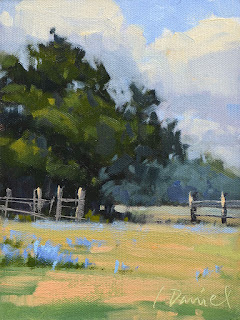Morning Reflections, 9 x 12, oil on panel, L. Daniel © 2010
Dear Blog Friends,
I was recently invited to write a guest post for "Realism Today", an online newsletter for artists. It went live this week, and here it is in its entirety. It's long, but it has lots of good info! (Click the title to see it in its original context.) Enjoy!
___________________
Guest post for Realism Today by Laurel Daniel
One of the most common challenges for beginning painters is learning to establish the feeling of distance in a landscape. It is a hurdle I remember well from my own early efforts… scenes looking flat, backgrounds jumping forward, and no sense of visual space to travel into. With much study and years of practice, I have discovered a number of ways to create that illusion of depth I so badly wanted back then. Below are five tips that have helped me in my journey, with examples for each. They can be considered individually, but I think you will find their actual use is very interconnected. Hopefully, the ideas will help you “see” your subject matter better.
1 - Atmospheric Perspective
Atmospheric perspective, or aerial perspective, is a technique that uses modification of tone to create a sense of depth. Simply described, natural conditions like fog and light have a softening effect on distant layers of the landscape. This impacts a painter’s color and value choices. I like to describe them in these two ways…
A) As objects move further away from the viewer: values become less contrasty, colors get weaker and cooler, and details become less distinct.
B) As objects come forward and closer to the viewer: values have more contrast, colors get stronger and warmer, and details become sharper.
In “Foggy Coastline” below, you can see this concept at work. Notice how each mountain range becomes weaker and cooler as it recedes into the distance. Conversely, the closest mountain range and people have greater contrast and more detail. The warmest/strongest color is in the sandy foreground.
Laurel Daniel, "Foggy Coastline", 9x12, oil on panel, plein air, contact artist
2 - Scale Shift
With the term scale shift, I am referring how our vantage point effects the appearance of size. Objects look smaller in size as they get farther away from us. Using this size shift helps us further enhance the feeling of depth in our paintings. When working with this concept, it's all about comparison in the big picture. Observe the relationships between “like” elements in foreground, middle ground, and background (compare grasses to grasses, clouds to clouds, etc), and incorporate the incremental differences as they actually occur in nature.
In “Morning Reflections” below, we see this scale shift with the grasses in ground plane and the clouds in the sky… both elements are larger in the foreground and get smaller in the distance.
Laurel Daniel, Morning Reflections, 9x12, oil on panel, plein air, contact artist
3 - Spacial Increments
Similar to scale shift where objects get smaller in the distance, the spaces between those objects also decrease. This is especially true for evenly spaced elements, like telephone poles, train tracks or orderly planted fruit trees in an orchard. Being intentional with this incremental change will not only give the illusion of depth, it will also keep the ground plane from looking flat.
In “Fruited Valley” below, notice how the spaces decrease between the vertical rows of grapevines as they go back, and between the horizontal rows of trees dividing the distant fields.
Laurel Daniel, "Fruited Valley", 24x30, oil on canvas, studio, private collection
4 - Overlapping Elements
Whenever a painter can partially cover one object with another, it gives the appearance of depth. Why? Because we can instantly identify layers, and layers create space.
In “Palm Tree Promenade” below, we view the ocean cove, mountain, and sky through the overlapping palm trees. This relationship (combined with a significant scale shift from foreground to background) establishes a great sense of depth.
Laurel Daniel, "Palm Tree Promenade", 8x8, oil on panel, plein air, private collection
5 - Practice, practice, practice!
Look for examples of these principles when selecting subject matter for paintings. I think you will find that searching with this in mind will also provide a jump-start with analyzing, composing and blocking in your chosen scene! If you can see it, you can paint it! Practice with a purpose.
In “Half Light” below, all of the ideas are at work… see if you can find them: atmospheric perspective, scale shift, spacial increments, and overlapping elements.
Laurel Daniel, "Half Light", 15x30, oil on canvas, studio, private collection


























